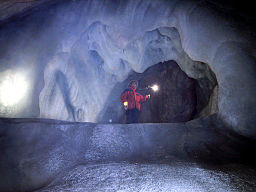Eisriesenwelt
| Eisriesenwelt | |
|---|---|

The interior of the caves
|
|
| Location of the caves in Austria | |
| Location |
Werfen (Salzburg, Austria) |
| Coordinates | 47°30′11″N 13°11′25″E / 47.502940°N 13.190250°ECoordinates: 47°30′11″N 13°11′25″E / 47.502940°N 13.190250°E |
| Length | 42 km |
| Elevation | 1,656 m |
| Discovery | 1879 |
| Geology | Ice cave |
| Entrances | 1 |
| Access | Public |
| Show cave opened | 1920 |
| Show cave length | 1,000 m |
| Visitors | 200,000 (by year) |
| Website | Official website |
The Eisriesenwelt (German for "World of the Ice Giants") is a natural limestone and ice cave located in Werfen, Austria, about 40 km south of Salzburg. The cave is inside the Hochkogel mountain in the Tennengebirge section of the Alps. It is the largest ice cave in the world, extending more than 42 km and visited by about 200,000 tourists every year.
The Tennengebirge mountains were formed during the late Tertiary period, during the Würm glaciation period of the . The mountain range, one of the massifs in the Austrian Alps, is the largest karst plateau in the Salzburger Alps, and the Eisriesenwelt is located at the rim of this plateau. Although the cave has a length of 42 km, only the first kilometer, the area that tourists are allowed to visit, is covered in ice. The rest of the cave is formed of limestone.
Eisriesenwelt was formed by the Salzach river, which eroded passageways into the mountain. The ice formations in the cave were formed by thawing snow which drained into the cave and froze during winter.
Since the entrance to the caves is open year-round, chilly winter winds blow into the cave and freeze the snow inside. In summer, a cold wind from inside the cave blows toward the entrance and prevents the formations from melting.
The first official discovery of Eisriesenwelt was by Anton Posselt, a natural scientist from Salzburg, in 1879, though he only explored the first two hundred meters of the cave. Before his discovery, the cave was known only to locals, who, believing that it was an entrance to Hell, refused to explore it. In 1880, Posselt published his findings in a mountaineering magazine, but the report was quickly forgotten.
Alexander von Mörk, a speleologist from Salzburg, was one of the few people who remembered Posselt's discovery. He led several expeditions into the caves beginning in 1912, which were soon followed by other explorers. Von Mörk was killed in World War I in 1914, and an urn containing his ashes is inside a niche in the cave. In 1920, a cabin for the explorers, Forscherhütte, was built and the first routes up the mountain were established. Tourists began to arrive soon after, attracted by the cave's sudden popularity. Later another cabin, the Dr. Oedl House, and paths from Werfen and Tänneck were constructed.
...
Wikipedia

